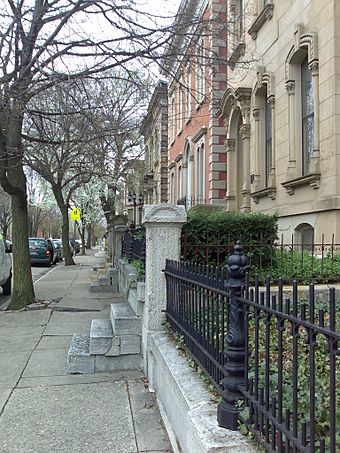Dayton Street Historic District facts for kids
Quick facts for kids |
|
|
Dayton Street Historic District
|
|
 |
|
| Location | Roughly bounded by Bank, Linn, and Poplar Sts. and Winchell Ave., Cincinnati, Ohio |
|---|---|
| Built | circa 1860 |
| Architect | Skaats, George W. |
| Architectural style | Italianate |
| NRHP reference No. | 73001457 |
| Added to NRHP | January 25, 1973 |
The Dayton Street Historic District is a special area in the West End neighborhood of Cincinnati, Ohio. It was once known as "Millionaires' Row." This is because many rich business owners lived there. They built huge, fancy houses between 1850 and 1890. This historic district is located near Bank Street, Poplar Street, Linn Street, and Winchell Avenue. It was officially added to the National Register of Historic Places on January 25, 1973. This means it's an important place to protect because of its history.
Contents
A Look Back at Dayton Street
When Cincinnati was first founded, the land where Dayton Street is now was far from the city center. Farmers used this land for their crops and animals. Some large stockyards, where animals were kept, were also nearby. Cincinnati was even called "Porkopolis" because of its big meatpacking industry!
From Farms to Fancy Homes
As Cincinnati grew bigger, wealthy people started building large country homes in this area. This began around 1840 and continued until the American Civil War. Most of the grand houses we see today were built between 1860 and 1880.
What Do the Houses Look Like?
The homes built during this time are usually tall, detached houses. This means they stand alone, not connected to other buildings. They are often made of brick or stone. Many of them are built in the Italianate style. This style was popular back then. It often features wide overhanging eaves, decorative brackets, and tall, narrow windows.
Who Lived on Millionaires' Row?
At its peak, Dayton Street was home to very successful businessmen. Many of them worked in Cincinnati's big meatpacking and brewing industries. These wealthy residents loved to make their homes look beautiful. They added things like stone walls and fancy cast iron fences. While some of these old details are gone, you can still see a lot of the original stonework and ironwork today.
Important Buildings in the District
The Dayton Street Historic District includes about 400 important buildings. Most of these are single-family houses. However, there are a few exceptions. For example, the old Police Station No. 5 on York Street is part of the district. You can also visit the Hauck House Museum at 812 Dayton Street. The house of former Mayor George Hatch is also nearby at 830 Dayton Street.



